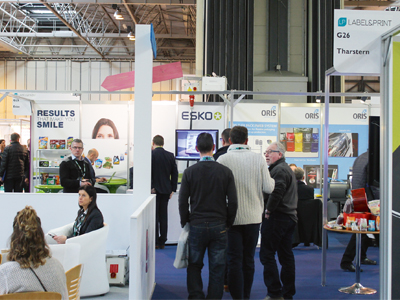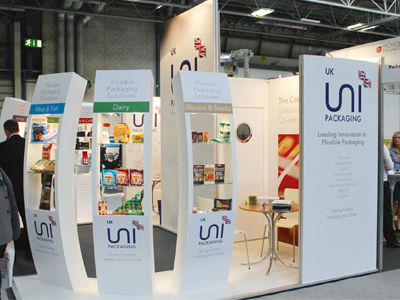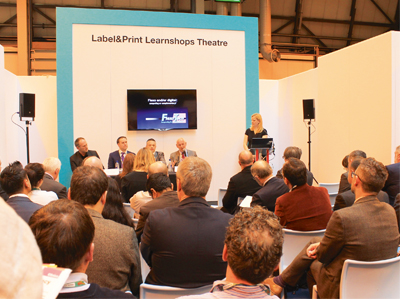Flexo and/or digital? That was the question asked at the FlexoTech panel debate
Numerous product launches, new features and over 40 seminars at the Packaging Innovations show helped set another record for Easyfairs in February. And FlexoTech’s panel debate on print technology proved so popular with visitors that it was standing room only for latecomers. By Neel Madsen and Michal Lodej.
While other print shows have suffered from falling visitor numbers in recent years, it was encouraging to once again receive impresssive stats from the latest edition of the Packaging Innovations show. Held on 25 and 26 February at the NEC Birmingham, the event had 6585 unique visitors through the doors and 350 exhibitors spread over five sections – Packaging Innovations (incorporating Contract Pack and EcoPack), Empack and Label&Print. This translates to a 10% rise from last year’s 6004 visitors.
Alison Church, event director for Easyfairs’ UK packaging events, commented, ‘The show has grown once again and the attendance figures are absolutely incredible. We couldn’t be happier with how this year’s show turned out and we want to thank all those who attended for making the show such a success. Having the very best and brightest of the packaging industry under one roof is always cause for celebration. Every area of the show was heaving throughout, and the feedback from visitors and exhibitors has been fantastic. It is great to be part of such a vibrant show celebrating its 10th anniversary.’
Flexo and/or digital?
On the second day of the show, FlexoTech hosted a panel debate on the merits of flexo versus digital print technology. Four leading printers, namely Tom Allum, chairman of Abbey Labels, David Webster, managing director of The Label Makers, Daragh Whelan, technical director at Adare, and Chris Tonge, Ultimate Packaging’s sales and marketing director, shared their views and experiences with the audience.
As the market is changing, printers are looking for ways to meet the demands for just-in-time delivery of labels and packaging, while print runs are getting shorter and shorter. Mr Tonge explained the challenge that Ultimate has faced in recent years, ‘Our volumes of flexible packaging are increasing every year, but the actual run length of each job is decreasing, so 18 months ago our average run length was 30,000 metres, last year it was 19,000 metres, and this year it will be down to 15,000 metres.’ Although Ultimate is a strong advocate for digital, and is the first in the UK to have installed an HP Indigo 20000 wide web digital press, this market only accounts for 1% of turnover and the company is still investing heavily in flexo with two new presses on order.
Abbey Labels is also still investing in both technologies. Mr Allum said, ‘About two or three years ago, we felt that the market was changing. There was more demand for short runs and various sorts, so we put in a Xeikon digital press which is now full to capacity.’ Interestingly he said that the digital press has highlighted deficiencies in the company’s conventional presses, so when it came to buying a new flexo press, it had a new benchmark to measure against. The choice was an MPS EF flexo press. ‘Our new MPS press has given us a wider product range. We wanted to do peel&reveal five page labels, and although we have been doing that for some time, the MPS due to its servo-drive, registration and speed can do it a lot faster. We found that at last the manufacturers could offer us a press where we could reduce makeready time and set up, and also offer us the high quality.’
The Label Makers has a mix of flexo, offset and digital presses, including an inkjet machine from Durst, and Mr Webster was quite clear in his view on the debate topic, ‘I strongly believe that there isn’t any one technology at the moment that can cover everything for us. We are still firm believers in flexo and have just installed a new 14 station flexo press last month, but it really depends on what market you want to serve. You have to look at what your customer base is, what they are going to ask you to produce and then you offer them the right solution for that particular product and market.’
But is digital necessarily the answer to shorter run lengths? Adare has taken a different route by investing in the ‘Digital Flexo’ concept which employs a very high level of automation on press. Mr Whelan said, ‘We have also seen a huge shift in our business with a lot of labels being replaced by flexible packaging, and we did look at digital because of the faster speed to market and shorter runs required, but we found that improvements in conventional presses were incredible.’ The company now has two Gidue Digital Flexo presses and can set up jobs in 10 minutes while lead times have been reduced to three to five days. ‘We really want to thank the digital guys for waking up the conventional press manufacturers,’ said Mr Whelan.
The debate then turned to how flexo can survive in the long run. Mr Tonge said, ‘I think speed of set up is absolutely paramount. If we can set up a wide web flexo job in 30 or even 20 minutes that is where flexo is going to score. And running speeds are still very different. Digital has got to go a lot faster before it really starts to replace flexo, but there is no doubt eventually it will do.’

Visitor numbers were up again this year
‘Press manufacturers have started to react, but in my opinion we need more automation but at a lower cost. Sometimes the options you need to save 10 minutes on set up are horrendously expensive. Hopefully those costs will come down,’ said Mr Allum. He also pointed out that some digital label printers are now finishing inline, an area where flexo could really improve. He continued, ‘I think there is another two or three generations to go in flexo press development to get them nearer to where digital is. Then the other threat of course is the speed of inkjet which seem at the moment to fit between toner-based digital and flexo. It will be very interesting to see how the flexo press manufacturers react to that.’
Mr Webster agreed, ‘When we go round shows like Labelexpo, we can see that most of the flexo press manufacturers are shortening the web, investing in fixed colour gamut and making other improvements, but I think they’ll have to change, and I think they will have to change quite quickly, if they are going to survive. Having said that, the digital people are also changing with inkjet now going up to 70 m/min, so there is this crossover, and it is going to be very interesting to watch developments over the next six months or so.’
More print debate
The show launched its first ever Drinks Symposium, which had speakers from The Lakes Distillery, Diageo and Glenfiddich demonstrating the power of packaging. Also new to the show were The Pharmaceutical Symposium and The Retail Symposium.
Chaired by Alison Church, the Big Print Debate returned with a large interactive audience, who gathered to hear an all-female panel of packaging experts discuss, ‘As personalisation increasingly becomes the norm will its greatest impact be on the shelf or in the home?’
Panellist Nancy Janes, who is HP’s WW graphics solutions business programme director, remarked, ‘It won’t become the norm. Technology keeps evolving and new formatting just hit the market, so digital print will continue to develop. Conventional packaging still has its place because volume will always be required; no one really wants personalised toilet rolls! Digital, hybrid and conventional print all complement each other.’
‘Getting the right balance is everything,’ said Karen Graley, packaging and reprographics manager at Waitrose. ‘Digital enables us to refresh and pimp up our products allowing the consumer to accessorise their home, so if they want a certain coloured box of tissues they can have it.’
‘Digital gives us the opportunity to tell our own story, but where personalisation needs to be in place, is in the right format and delivered in the right way and at the right price point,’ commented Lynn Harris, account director, digital, at design agency jkr.
Global packaging and materials consultant at SABMiller, Antoinette Devine, said, ‘Personalisation is different to customisation; people will pay more for personalisation but not necessarily for customisation. People don’t want all their groceries personalised, it should be kept for luxury goods to keep them special.’
‘It is an exciting time’, concluded Ms Janes. ‘People want personalised packaging, so brand managers should try it to see the effect it has on their products. Start small and if it works roll it out, but just try it!’

There were many great stands, such as this one from Uni Packaging
To WiP or not to WiP
Continuing the all-female theme was ‘Women in Packaging’, a new organisation launched at the show, designed to connect, support and recognise female employees within the packaging industry.
Founded by Joanna Stephenson and Debbie Waldron-Hoines, this three-strand approach will see networking events up and down the country where inspirational women from the industry will speak on relevant topics. There will also be a new post graduate scheme where participants can study towards a certificate, and an online mentoring scheme that will allow women to support each other and share their expertise. Finally an annual awards programme will be set up to celebrate strong females in the packaging industry.
Ms Stephenson commented, ‘The Women in Packaging launch was really well received, with 50 women from right across the brand, retail and packaging sectors in attendance. I am already looking forward to the next networking event and building the database of women moving forward.’
Fed to the lions
In the Lions’ Lair, Adam Mings, packaging innovation manager at 2 Sisters Food Group, and Richard Savage, co-founder at Retail in Action, judge the entries. There was a good selection from across the packaging supply chain.
Paul Derby from Miliken Europe showed off the company’s advancements with polypropylene, the Millad(R) NX 8000. The company has developed a way to remove the cloudy look of plastic to make it more appealing to packaging designers, but crucially it is still safe to use as food packaging and is recyclable.
Bernard Wimbury, from TSS Technology, showed a device that measures the flatness of corrugated board to within one micron, the Peret Corrcheck. This gives printers and corrugated manufacturers alike an easy way of testing board, and offers potential cost savings.
Simon Breeze from Duncan Print shared the company’s latest project of printing food containers to be used at football grounds. The ordinary burger box or hot dog tray is transformed by taking on the clubs’ badge and colours.
However, the winning entry came from farther down the packaging supply chain. Cecile Pompili from Promens, part of the CEC Group, showed off the Slidissime. The tactile ‘touch & slide’ pump with revolutionary airless technology designed for the cosmetics industry wowed judges and attendees alike. Now apparently, women don’t like to put their fingers into pots of cream; this device uses vacuum technology to get the cream out of the jar by just sliding your finger across the top of the tub.
‘It was an honour to be up against three strong competitors in the Lair, all with brilliant products. It is however great to say we are the winners! It shows how relevant the Slidissime is to the UK market and that there is a real hunger within the cosmetics industry for a prestigious airless jar.’
Feedback
The Benson Group had Masterchef finalist Dhruv Baker cooking up a storm for visitors attending its stand. Mr Baker said, ‘I have thoroughly enjoyed cooking for the show’s enthusiastic visitors and we’ve had lots of really inquisitive people, who have loved both the food and the packaging.’
Nikki Clark, marketing manager at Benson Group, added, ‘Packaging Innovations is always the highlight of our exhibiting calendar, and this 10th anniversary year was particularly successful for us both in terms of visitor footfall to our stand and in the number of positive business leads we generated. Our Theatre of Food was a new venture and having the fantastically charismatic Dhruv Baker doing live cooking demonstrations was a really exciting way to entice the crowds.’
Nick Smith, managing director at Parkside Group also exhibiting at the show, said, ‘The show has enabled us to raise our profile as a genuine specialty packaging innovations provider and the feedback on what we’ve shown, as well as attendance to the stand, has been fantastic. The quality of the visitors has been excellent and we expect to develop some significant new business as a result.’
Carol Burdett, commercial director at National Flexible, was equally enthusiastic, ‘What a fantastic two days! We met both existing customers and new prospects on the stand, but we also had some really excellent enquiries from new people. Everyone was buoyant and seemed to have new projects to discuss. We felt it was so successful for us that we have decided to double the size of our stand for next year!’






